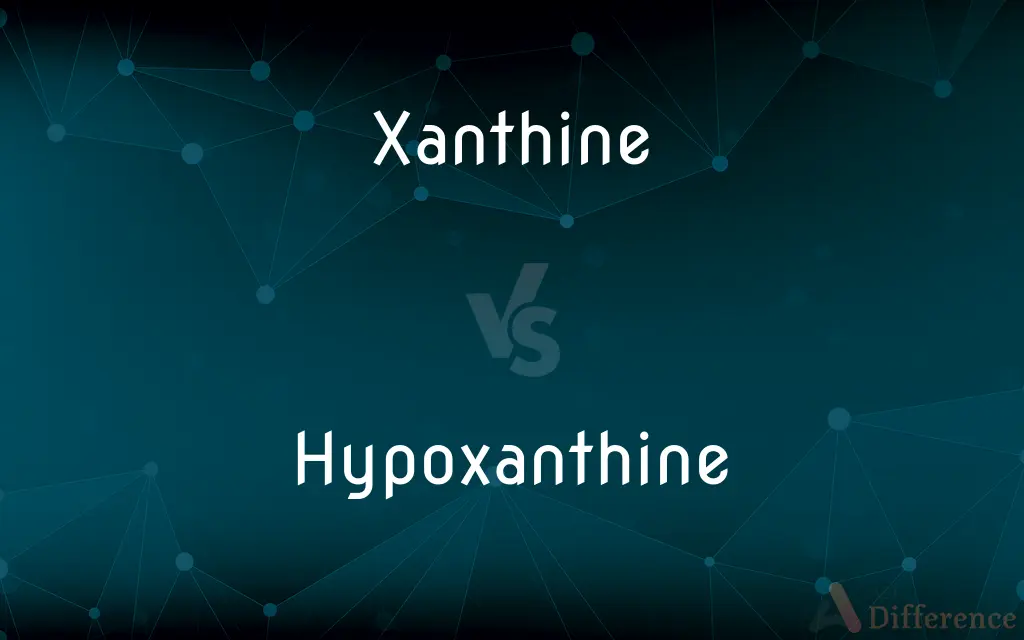Xanthine vs. Hypoxanthine — What's the Difference?
By Tayyaba Rehman & Fiza Rafique — Updated on April 17, 2024
Xanthine is a key intermediate in purine degradation and synthesis, used in metabolism and excretion, while hypoxanthine is a purine derivative that serves as a precursor in the synthesis of nucleic acids.

Difference Between Xanthine and Hypoxanthine
Table of Contents
ADVERTISEMENT
Key Differences
Xanthine forms as an intermediate product in the metabolic pathway of purine degradation and also participates in the synthesis of vital components like uric acid. In contrast, hypoxanthine is primarily involved in the salvage pathways, where it acts as a precursor to nucleotides like guanine and adenine, which are essential for DNA and RNA synthesis.
Xanthine is oxidized from hypoxanthine by the enzyme xanthine oxidase in one of the key steps in the catabolism of purines, leading to the formation of uric acid, an important compound in the body that helps in the excretion of excess nitrogen. On the other hand, hypoxanthine is generated from the breakdown of adenine and can be reutilized in the synthesis of nucleic acids, helping conserve energy and resources within the cell.
While xanthine itself can crystallize and contribute to diseases such as gout or kidney stones if accumulated excessively, hypoxanthine is less likely to contribute directly to such conditions but can elevate levels of uric acid when converted back to xanthine and further metabolized.
The biochemical pathways involving xanthine are generally associated with degradation processes that help in purging the body of excess purines. Conversely, hypoxanthine plays a critical role in the salvage pathways, a system that recycles purines and helps in maintaining adequate nucleotide pools for cellular functions.
The therapeutic implications of understanding xanthine metabolism include managing conditions like gout through inhibitors of xanthine oxidase, such as allopurinol. Hypoxanthine levels, however, are more closely monitored in contexts like organ transplantation and certain genetic disorders, reflecting its role in cellular turnover and growth.
ADVERTISEMENT
Comparison Chart
Role in Metabolism
Intermediate in purine degradation
Precursor in nucleotide salvage pathway
Enzymatic Conversion
Oxidized from hypoxanthine
Reduced to form nucleotides
Associated Conditions
Gout, kidney stones (due to crystallization)
Utilized in nucleic acid synthesis
Biological Importance
Leads to uric acid production
Essential for DNA and RNA recycling
Therapeutic Relevance
Target for gout treatment
Monitored in organ transplantation, genetic disorders
Compare with Definitions
Xanthine
A compound in the pathway of purine metabolism.
Xanthine is a precursor to uric acid in human metabolism.
Hypoxanthine
A precursor to nucleic acids via salvage pathways.
Hypoxanthine gets converted back to adenine or guanine in cells.
Xanthine
An intermediate that can crystallize in excess.
High xanthine levels can lead to the formation of kidney stones.
Hypoxanthine
A purine derivative important in nucleotide salvage.
Hypoxanthine is recycled back into nucleic acids, conserving cellular resources.
Xanthine
A target for therapeutic inhibition in gout.
Allopurinol inhibits xanthine oxidase to reduce gout symptoms.
Hypoxanthine
Less directly associated with disease than xanthine.
Unlike xanthine, hypoxanthine does not commonly form crystals that cause gout.
Xanthine
A metabolic product oxidized by xanthine oxidase.
Xanthine oxidase converts xanthine into uric acid, important in gout management.
Hypoxanthine
Monitored in clinical settings for organ health.
Hypoxanthine levels are checked to assess organ viability during transplantation.
Xanthine
Associated with degradation of purines.
Xanthine plays a crucial role in breaking down purines to simpler forms.
Hypoxanthine
Involved in conserving energy in cellular processes.
The recycling of hypoxanthine is vital for efficient cellular metabolism.
Xanthine
Xanthine ( or ; archaically xanthic acid; systematic name 3,7-dihydropurine-2,6-dione) is a purine base found in most human body tissues and fluids, as well as in other organisms. Several stimulants are derived from xanthine, including caffeine, theophylline, and theobromine.Xanthine is a product on the pathway of purine degradation.
Hypoxanthine
Hypoxanthine is a naturally occurring purine derivative. It is occasionally found as a constituent of nucleic acids, where it is present in the anticodon of tRNA in the form of its nucleoside inosine.
Xanthine
A yellowish-white, crystalline purine base, C5H4N4O2, that is a precursor of uric acid and is found in blood, urine, muscle tissue, and certain plants.
Hypoxanthine
A white powder, C5H4N4O, that is an intermediate in the metabolism of animal purines.
Xanthine
Any of several derivatives of this compound.
Hypoxanthine
(organic compound) A bicyclic heterocycle, 3,7-dihydropurin-6-one, that is an intermediate in the biosynthesis of uric acid.
Xanthine
(chemistry) Any of a group of alkaloids that include caffeine, theophylline, and theobromine as well as the parent compound, a precursor of uric acid found in many organs of the body.
Xanthine
A type of purine obtainable as a white microcrystalline powder, C5H4O2N4, present in muscle tissue, in the liver, spleen, pancreas, and other organs, and also in urine (in small quantities) and some urinary calculi, and in the juices of certain plants; - so called because it leaves a yellow residue when evaporated to dryness with nitric acid. It is also present in guano. Xanthine is closely related to uric acid.
Xanthine
Crystalline oxidation product of the metabolism of nucleoproteins; precursor of uric acid; found in many organs and in urine
Common Curiosities
Why is xanthine important in medical treatments?
Xanthine is a target in the treatment of gout, where inhibitors of xanthine oxidase can reduce uric acid production.
Can hypoxanthine cause gout?
While hypoxanthine itself does not cause gout, its conversion into xanthine and then uric acid can contribute to gout if these latter compounds accumulate excessively.
How does hypoxanthine contribute to nucleic acid synthesis?
Hypoxanthine acts as a precursor in the salvage pathways, getting converted back into nucleotides like adenine and guanine.
What enzyme converts hypoxanthine to xanthine?
Xanthine oxidase converts hypoxanthine to xanthine in purine metabolism.
How do the roles of xanthine and hypoxanthine differ in purine metabolism?
Xanthine is involved in degradation pathways leading to uric acid, while hypoxanthine is crucial for the recycling of purines in salvage pathways.
What is xanthine primarily used for in the body?
Xanthine is used in the metabolism and excretion of purines, forming uric acid as a final product.
How do xanthine and hypoxanthine levels affect therapeutic approaches?
Elevated xanthine levels are managed with inhibitors to prevent gout, while hypoxanthine levels are important indicators in genetic disorders and organ health.
What diseases are associated with excess xanthine?
Excess xanthine can lead to conditions like gout and kidney stones due to its ability to crystallize.
What role does hypoxanthine play in organ transplantation?
Hypoxanthine levels are monitored in organ transplantation to assess the viability and health of transplanted tissues.
What is the difference between xanthine and hypoxanthine in their biochemical pathways?
Xanthine is primarily involved in the catabolic pathways of purine degradation, whereas hypoxanthine functions in the anabolic salvage pathways of nucleotides.
Share Your Discovery

Previous Comparison
Katydid vs. Locust
Next Comparison
Objection vs. ObjectionableAuthor Spotlight
Written by
Tayyaba RehmanTayyaba Rehman is a distinguished writer, currently serving as a primary contributor to askdifference.com. As a researcher in semantics and etymology, Tayyaba's passion for the complexity of languages and their distinctions has found a perfect home on the platform. Tayyaba delves into the intricacies of language, distinguishing between commonly confused words and phrases, thereby providing clarity for readers worldwide.
Co-written by
Fiza RafiqueFiza Rafique is a skilled content writer at AskDifference.com, where she meticulously refines and enhances written pieces. Drawing from her vast editorial expertise, Fiza ensures clarity, accuracy, and precision in every article. Passionate about language, she continually seeks to elevate the quality of content for readers worldwide.












































